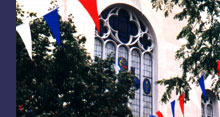It
held a political dynasty from 1933 until 1979, since every Chicago
mayor was from Bridgeport: Edward J. Kelly, Martin Kennelly, Richard
J. Daley and Michael Bilandic (St. Jerome's parishioner).
The
community got its name from the fact that there was a low bridge
near the South Fork in the 1840s and heavily-loaded canal boats
had to unload items from the decks and carry them around it.
Bridgeport extends from the Stevenson Expressway north to Pershing
Road on the south, and from the Conrail tracks on the east to
Bubbly Creek (a small fork of the Chicago River) on the west.
In the 1830s and early 1840s, its original settlers were Irish
canalers. These squatters built their shanties on federal land
-- the canal banks -- near the source of fresh water. Bridgeport
was a city suburb until 1863.
In the 1850s, it was alleged that Bridgeport residents had illegally
voted in a Chicago mayoral election.
Industries
included the canal, the meatpacking houses (in 1865 consolidated
into the Union Stock Yards), a limestone quarry at Halsted and
29th Street, brickyards, and Illinois Steel (built in 1870 at
Archer and Ashland avenues). These have all disappeared except
the quarry. The Union Stock Yards lasted until 1971.
Bridgeport residents subsequently became merchants, saloonkeepers,
teachers, clergymen -- but more than anything else -- politicians,
policemen and city employees. Political patronage has long flourished
here.
The northeast corner of Bridgeport abuts Chinatown and, beginning
in the 1970s, Chinese-Americans have begun to move into Bridgeport.
In two census tracts, the figure for 'non-whites' in Bridgeport
jumped from 2.9 percent in each in 1970 to 10.9 percent in one
census and 25.2 percent in the other by 1980.
Bridgeport's population decreased from 35,167 in 1970 to 30,923
in 1980, half of what it was in 1920. It dropped a little to 29,877
in 1990. Among those who have moved out, however, have been Mayor
Richard M. Daley and his family.



